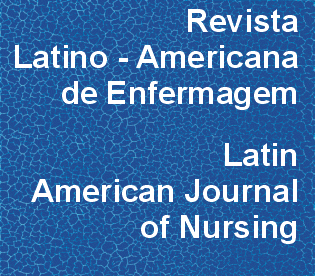Validity of the DISABKIDS® - Cystic Fibrosis Module for Brazilian children and adolescents
DOI:
https://doi.org/10.1590/0104-1169.3450.2485Abstract
OBJECTIVES: to validate the health-related quality of life measuring instrument DISABKIDS(r) - Cystic Fibrosis Module (self version) for Brazilian children and adolescents. METHOD: methodological study in which a sample of 113 participants (54 girls and 59 boys; mean age 11.91 years and SD=2.79) was considered, from four Brazilian states, São Paulo, Paraná, Minas Gerais and the Federal District, 51 of whom participated in the pilot study and 62 in the field study. The answers to the questionnaire were analyzed, considering the frequency distributions with regard to the floor and ceiling effects, Cronbach's Alpha statistics, Pearson's Linear Correlation Coefficient, Mulitrait-Multimethod analysis and Confirmatory Factor Analysis according to Structural Equations Modeling. RESULTS: the instrument showed a high internal consistency coefficient (verified using Cronbach's Alpha) and construct validity, according to the Multitrait-Multimethod analysis. The DISABKIDS(r) - Cystic Fibrosis Module, self version, maintained the same factorial structure as in the originally proposed model. CONCLUSION: the instrument validation has been finished and indicates that the self version is validated for use in Brazil and can be included into the monitoring routine of this population.Downloads
Download data is not yet available.
Downloads
Published
2014-10-01
Issue
Section
Original Articles
License
RLAE’s authorship concept is based on the substantial contribution by each of the individuals listed as authors, mainly in terms of conceiving and planning the research project, collecting or analyzing and interpreting data, writing and critical review. Indication of authors’ names under the article title is limited to six. If more, authors are listed on the online submission form under Acknowledgements. The possibility of including more than six authors will only be examined on multicenter studies, considering the explanations presented by the authors.Including names of authors whose contribution does not fit into the above criteria cannot be justified. Those names can be included in the Acknowledgements section.
Authors are fully responsible for the concepts disseminated in their manuscripts, which do not necessarily reflect the editors’ and editorial board’s opinion.
How to Cite
Validity of the DISABKIDS® - Cystic Fibrosis Module for Brazilian children and adolescents . (2014). Revista Latino-Americana De Enfermagem, 22(5), 819-825. https://doi.org/10.1590/0104-1169.3450.2485



